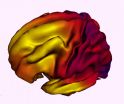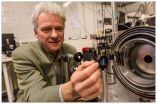How immune cells facilitate the spread of breast cancer
2015-03-30
(Press-News.org) The body's immune system fights disease, infections and even cancer, acting like foot soldiers to protect against invaders and dissenters. But it turns out the immune system has traitors amongst their ranks. Dr. Karin de Visser and her team at the Netherlands Cancer Institute discovered that certain immune cells are persuaded by breast tumors to facilitate the spread of cancer cells. Their findings are published advanced online on March 30 in the journal Nature.
In Western countries about one in eight women will develop breast cancer. Of the women who die of this disease, 90 percent dies because the cancer has spread to other parts of their body and formed metastases. For this reason, cancer researchers are trying to understand how the process of metastasis occurs. A few years ago, it was reported that breast cancer patients with a high number of immune cells called neutrophils in their blood are at increased risk of developing metastases. Immune cells are supposed to protect our body. So why are high neutrophil levels linked to worse outcome in women with breast cancer?
Dr. Karin de Visser, group leader at the Netherlands Cancer Institute, and her team discovered that certain types of breast tumors cause a domino effect of reactions within the immune system. The tumor sends out signaling molecules that through a number of steps cause the immune system to produce lots of neutrophils. This normally happens as part of an inflammatory reaction, but the neutrophils that are activated by the tumor behave differently. It turns out they are able to block the actions of other immune cells, called T cells. T cells are the cells that can (sometimes) recognize and kill cancer cells.
De Visser and her team went on to discover that a signaling protein called interleukin 17 (or IL17) is important for this process. "We saw in our experiments that IL17 is crucial for the increased production of neutrophils", says De Visser. "And not only that, it turns out that this is also the molecule that changes the behavior of the neutrophils, causing them to become T cell inhibitory."
The first author of the paper in Nature, postdoctoral researcher Seth Coffelt, showed the importance of the IL17-neutrophil pathway by inhibiting this pathway in a mouse model that mimics human breast cancer metastasis. When neutrophils were inhibited, the animals developed much less metastases than animals from the control group, in which the IL17-neutrophil route was not inhibited. "What's notable is that blocking the IL17-neutrophil route prevented the development of metastases, but did not affect the primary tumor," De Visser comments. "So this could be a promising strategy to prevent the tumor from spreading."
Since neutrophils are important to protect us from infections, drugs that inhibit neutrophils would make patients susceptible to all kinds of infections. Inhibition of IL17 might be a safer strategy. In fact, drugs that do so already exist. Anti-IL17 drugs are currently being tested in clinical trials as a treatment for inflammatory diseases, like psoriasis and rheumatism. Last month, the first anti-IL17 based therapy for psoriasis patients was approved by the U.S. Federal Drug Administration (FDA). "It would be very interesting to investigate whether these already existing drugs are beneficial for breast cancer patients. It may be possible to turn these traitors of the immune system back towards the good side and prevent their ability to promote breast cancer metastasis," De Visser says.
INFORMATION:
This research project was made possible by funding from the Dutch Cancer Society, The Netherlands Organisation for Scientific Research and the European Union.
ELSE PRESS RELEASES FROM THIS DATE:
2015-03-30
Researchers at NYU Langone Medical Center have captured images of the underlying biological activity within brain cells and their tree-like extensions, or dendrites, in mice that show how their brains sort, store and make sense out of information during learning.
In a study to be published in the journal Nature online March 30, the NYU Langone neuroscientists tracked neuronal activity in dendritic nerve branches as the mice learned motor tasks such as how to run forward and backward on a small treadmill. They concluded that the generation of calcium ion spikes -- which ...
2015-03-30
A lower percentage of children are eating fast food on any given day and calories consumed by children from burger, pizza and chicken fast food restaurants also has dropped, according to an article published online by JAMA Pediatrics.
Colin D. Rehm, Ph.D., M.P.H., formerly of the University of Washington, Seattle, now of the Friedman School of Nutrition Science and Policy at Tufts University, Boston, and Adam Drewnowski, Ph.D., of the University of Washington, Seattle, analyzed data from the National Health and Nutrition Examination Survey from 2003 to 2010 to examine ...
2015-03-30
The medication glyburide, which has been increasingly used to treat gestational diabetes in pregnant women, was associated with higher risk for newborns to be admitted to a neonatal intensive care unit, have respiratory distress, hypoglycemia (low blood glucose), birth injury and be large for gestational age compared with infants born to women treated with insulin, according to an article published online by JAMA Pediatrics.
The prevalence of gestational diabetes mellitus (GDM) in the United States has more than doubled during the last 20 years. Given the widespread and ...
2015-03-30
Turns out, an apple a day won't keep the doctor away but it may mean you will use fewer prescription medications, according to an article published online by JAMA Internal Medicine.
The apple has come to symbolize health and healthy habits. But can apple consumption be associated with reduced health care use because patients who eat them might visit doctors less?
Matthew A. Davis, D.C., M.P.H., Ph.D., of the University of Michigan School of Nursing, Ann Arbor, and coauthors analyzed data from the National Health and Nutrition Examination Survey (2007-2008 and 2009-2010) ...
2015-03-30
Scientists have developed tiny 'nanoneedles' that have successfully prompted parts of the body to generate new blood vessels, in a trial in mice.
The researchers, from Imperial College London and Houston Methodist Research Institute in the USA, hope their nanoneedle technique could ultimately help damaged organs and nerves to repair themselves and help transplanted organs to thrive.
The nanoneedles work by delivering nucleic acids to a specific area. Nucleic acids are the building blocks of all living organisms and they encode, transmit and express genetic information. ...
2015-03-30
Characterizing associations between socioeconomic factors and children's brain development, a team including investigators from nine universities across the country reports correlative links between family income and brain structure. Relationships between the brain and family income were strongest in the lowest end of the economic range - suggesting that interventional policies aimed at these children may have the largest societal impact. The study, led by researchers at The Saban Research Institute of Children's Hospital Los Angeles and Columbia University Medical Center, ...
2015-03-30
A new study has confirmed the existence of a positive feedback operating in climate change whereby warming itself may amplify a rise in greenhouse gases resulting in additional warming.
The study, published in the journal Nature Climate Change, shows that in addition to the well understood effect of greenhouse gases on the Earth's temperature, researchers can now confirm directly from ice-core data that the global temperature has a profound effect on atmospheric greenhouse gas concentrations. This means that as the Earth's temperature rises, the positive feedback in the ...
2015-03-30
Hamilton, ON (March 30, 2015) - Researchers from McMaster University and the Icahn School of Medicine at Mount Sinai, New York have discovered that a protein associated with neurodegenerative diseases like ALS also plays an important role in the body's natural antiviral response.
The study, published today in Nature Immunology, offers new insight into the link between neurodegenerative disorders and inflammation, and provides a framework to explore more fully the possibility that viral infection may lead to onset of these diseases.
Matthew Miller, an investigator at ...
2015-03-30
There are electrical signals in the nervous system, the brain and throughout the human body and there are tiny magnetic fields associated with these signals that could be important for medical science. Researchers from the Niels Bohr Institute have just developed a method that could be used to obtain extremely precise measurements of ultra-small magnetic fields. The results are published in the scientific journal Nature Physics.
The tiny magnetic fields are all the way down on the atomic level. The atoms do not stand still, they revolve around themselves and the axis is ...
2015-03-30
Washington, D.C.-- The 2000-2003 drought in the American southwest triggered a widespread die-off of forests around the region. A Carnegie-led team of scientists developed a new modeling tool to explain how and where trembling aspen forests died as a result of this drought. It is based on damage to the individual trees' ability to transport water under water-stressed conditions.
If the same processes and threshold govern the future, their results suggest that more widespread die-offs of aspen forests triggered by climate change are likely by the 2050s. Tree mortality ...
LAST 30 PRESS RELEASES:
[Press-News.org] How immune cells facilitate the spread of breast cancer




